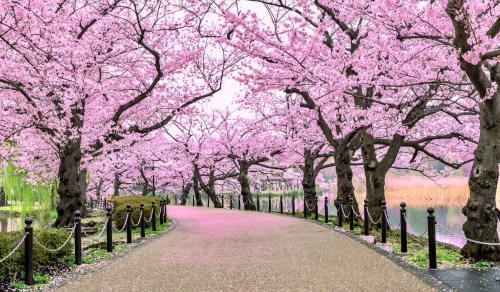Traveling to Japan for the first time is both exciting and overwhelming. Its rich cultural heritage, bustling cities, serene temples, and iconic landscapes make Japan a must-see. But where do you begin? Make the most of your time in Japan with this comprehensive 7-day itinerary that covers Tokyo, Kyoto, and Nara—three of the country’s most fascinating cities. The perfect balance of adventure and relaxation can be found in this guide, whether you’re interested in historical sites, food, shopping, or nature.
Key Takeaways
- Tokyo offers a bustling mix of modern and traditional, from Shibuya Crossing to Asakusa’s temples.
- Kyoto is a cultural haven, home to iconic temples, gardens, and historic districts.
- Nara provides a peaceful escape with its famous deer park and impressive temples.
- Alternative destinations like Hakone and Takayama offer a more serene and immersive experience of Japan’s countryside.
First-time visitor’s guide to Japan’s perfect 7-day itinerary
Day 1 of the Japan Itinerary: Tokyo—See the City of Contrasts
Tokyo is your destination! You can’t start your Japan adventure in a better city than this vibrant metropolis, where modernity meets tradition.
Morning: Arriving in Tokyo
- Airport: Most international flights land at either Narita International Airport (NRT) or Haneda Airport (HND).
- Narita is about 60 km from the city center. A one-way ticket on the Narita Express (N’EX) costs around ¥3,070 ($28 USD). Alternatively, the Keisei Skyliner is faster and costs about ¥2,520 ($23 USD).
- Haneda is closer, with a monorail ride into Tokyo costing about ¥500 ($4.50 USD).
Travel Tip: If you’re planning multiple train journeys, consider purchasing the Japan Rail Pass (JR Pass) in advance. A 7-day JR Pass costs around ¥29,650 ($210 USD) and offers unlimited travel on JR trains, including shinkansen (bullet trains).
Afternoon: Asakusa and Senso-ji Temple
Head to Asakusa, one of Tokyo’s oldest districts, to see the iconic Senso-ji Temple. The atmosphere here is lively, with food stalls and traditional shops lining Nakamise-dori, a shopping street leading up to the temple.
- Entry Fee: Free
- Rating: 4.7/5 (TripAdvisor)
Lunch Recommendation: Try the local specialty, tempura, at Daikokuya Tempura (around ¥2,500/$22 USD per person).
Evening: Tokyo Skytree
After exploring Asakusa, take a short trip to Tokyo Skytree, the world’s tallest tower. The observation deck offers stunning views of Tokyo, especially at sunset.
- Entry Fee: ¥3,100 ($28 USD) for the Tembo Deck
- Rating: 4.5/5 (Google Reviews)
Dinner Suggestion: Head to Omoide Yokocho near Shinjuku for yakitori (grilled skewers) at one of the tiny, atmospheric restaurants. A meal here typically costs around ¥2,000 ($18 USD).
Day 2 of Japan Itinerary: Shibuya, Shinjuku, and Harajuku
As you spend your second day in Tokyo, you’ll discover the city’s trendy neighborhoods, each with their own unique charm.
Morning: Shibuya Crossing and Hachiko Statue
Start your day at the famous Shibuya Crossing, one of the busiest intersections in the world. Don’t forget to stop by the Hachiko Statue, which commemorates the loyal Akita dog who waited for his owner every day, even after his death.
- Best Time to Visit: Morning to avoid heavy crowds
- Entry Fee: Free
Breakfast Stop: Try a coffee at Starbucks Shibuya (¥600/$5.50 USD), offering a perfect view of the crossing from the second-floor window.
Afternoon: Meiji Shrine and Harajuku
Walk over to Meiji Shrine, an oasis of calm in the heart of the city. Nestled within Yoyogi Park, this Shinto shrine is dedicated to Emperor Meiji and Empress Shoken.
- Entry Fee: Free
- Rating: 4.6/5 (Google Reviews)
Afterward, head to Takeshita Street in Harajuku, famous for its quirky shops, colorful fashion, and trendy cafés. Indulge in the area’s most popular street food, crepes (around ¥500/$4.50 USD).
Evening: Shinjuku and Golden Gai
Explore Shinjuku, one of Tokyo’s most vibrant districts. Visit the Tokyo Metropolitan Government Building for a free observation deck with panoramic views.
- Entry Fee: Free
- Rating: 4.3/5 (Google Reviews)
Afterward, discover the tiny bars of Golden Gai, a network of narrow alleys with over 200 small bars, each offering a unique atmosphere. Expect to pay around ¥1,000 ($9 USD) for a drink and a small seating charge.
On Day 3 of your Japan tour, you will visit Tokyo’s Akihabara, Ginza, and Odaiba districts
Today is all about experiencing the modern and futuristic sides of Tokyo.
Morning: Akihabara (Electric Town)
Explore Akihabara, Tokyo’s electronic and otaku (anime and manga) hub. Whether you’re looking for electronics, video games, or anime collectibles, this is the place to be.
- Must-Visit: Yodobashi Camera, a massive electronics store
- Entry Fee: Free to explore, but budget for shopping
Lunch Stop: Try Ichiran Ramen in Akihabara (around ¥1,000/$9 USD). Ichiran’s specialty is tonkotsu (pork-based) ramen, and it’s a favorite among locals and tourists alike.
Afternoon: Ginza, Tokyo’s Luxury Shopping District
Next, head to Ginza, Tokyo’s luxury shopping district, known for its upscale boutiques, high-end restaurants, and sleek architecture.
- Must-Visit: Ginza Six shopping complex
- Entry Fee: Free to explore
Afternoon Tea: Try Ginza West for delicious pastries and coffee (around ¥1,500/$14 USD).
Evening: Odaiba—The Futuristic Waterfront
End your day at Odaiba, a futuristic shopping and entertainment district on Tokyo Bay. Visit the DiverCity Tokyo Plaza to see the life-sized Gundam Statue or relax on Odaiba Beach while enjoying views of the Rainbow Bridge.
- Entry Fee: Free (except for special exhibits)
- Rating: 4.2/5 (TripAdvisor)
For dinner, try Sushi Dai in Odaiba (around ¥3,000/$27 USD), famous for its fresh sushi and waterfront views.
The fourth day of your Japan itinerary includes Kyoto, a traditional Japanese city
After three days in Tokyo, it’s time to hop on the shinkansen to Kyoto, Japan’s cultural heart. The bullet train ride takes around 2.5 hours.
Morning: Fushimi Inari Shrine
Start your Kyoto journey by visiting Fushimi Inari Shrine, known for its thousands of red torii gates that create a stunning tunnel through the mountain.
- Entry Fee: Free
- Rating: 4.8/5 (Google Reviews)
Travel Tip: Arrive early in the morning (before 9 AM) to avoid crowds, especially if you want to take unobstructed photos of the famous torii gates.
Afternoon: Nishiki Market
Next, head to Nishiki Market, known as “Kyoto’s Kitchen.” Sample local delicacies such as yuba (tofu skin), grilled seafood, and mochi.
- Entry Fee: Free to explore, but expect to spend around ¥1,000 ($9 USD) for a small meal.
- Rating: 4.3/5 (TripAdvisor)
Evening: Gion District
End the day by exploring Gion, Kyoto’s famous geisha district. Stroll down Hanami-koji Street and enjoy the traditional wooden machiya houses. If you’re lucky, you might even spot a maiko (apprentice geisha).
- Dinner: Enjoy a traditional kaiseki meal at Kikunoi (around ¥10,000/$90 USD per person).
- Rating: 4.5/5 (Michelin Guide)
In this fifth day of the Japan itinerary, we explore Kyoto, where we explore temples, gardens, and bamboo groves
Day 5 is all about Kyoto’s famous temples and natural beauty.
Morning: Kinkaku-ji (Golden Pavilion)
Visit Kinkaku-ji, also known as the Golden Pavilion, one of Kyoto’s most iconic landmarks. The shimmering golden structure surrounded by a tranquil pond and gardens is a photographer’s dream.
- Entry Fee: ¥400 ($3.50 USD)
- Rating: 4.7/5 (TripAdvisor)
Afternoon: Arashiyama Bamboo Grove
Head to Arashiyama, located on the outskirts of Kyoto, to visit the Arashiyama Bamboo Grove. The towering bamboo stalks create a serene and otherworldly atmosphere.
- Entry Fee: Free
- Rating: 4.4/5 (Google Reviews)
Lunch Recommendation: Try Yudofu Sagano for a traditional tofu meal in a serene garden setting (around ¥2,500/$22 USD).
Evening: Pontocho Alley
In the evening, visit Pontocho Alley, a narrow street packed with traditional restaurants and bars. Dine along the Kamo River for a truly magical experience.
- Dinner: Sample yakitori at Torito Pontocho (around ¥3,000/$27 USD).
- Rating: 4.3/5 (Google Reviews)
Japan Itinerary Day 6: Nara-Temples and Deer Park
Nara, just a short train ride from Kyoto, is known for its friendly deer and impressive temples.
Morning: Nara Deer Park
Start your day at Nara Deer Park, where you can feed the tame deer that roam freely. Purchase shika senbei (deer crackers) for around ¥200 ($1.80 USD) and watch the deer bow to you in exchange for a treat!
- Entry Fee: Free (deer crackers ¥200)
- Rating: 4.6/5 (TripAdvisor)
Afternoon: Todai-ji Temple
Visit Todai-ji Temple, home to the world’s largest bronze statue of Buddha (Daibutsu). The temple’s Great Buddha Hall is equally impressive, both in scale and design.
- Entry Fee: ¥600 ($5.50 USD)
- Rating: 4.7/5 (TripAdvisor)
Lunch Suggestion: Try Kamakura Pasta, known for its handmade Japanese-style pasta dishes (around ¥1,500/$14 USD).
Evening: Return to Kyoto
After exploring Nara, head back to Kyoto for a relaxed evening. Consider a casual izakaya dinner at Nishiki Warai, offering okonomiyaki (Japanese savory pancakes) for around ¥1,000 ($9 USD).
Japan Itinerary Day 7: Back to Tokyo: A Relaxed Farewell
On your final day, take the bullet train back to Tokyo. Use the day to explore the city at a slower pace, picking up souvenirs and revisiting any favorite spots.
Morning: Tsukiji Outer Market
If you’re an early riser, visit Tsukiji Outer Market for fresh seafood and local snacks. Even though the inner wholesale market has moved to Toyosu, the outer market is still bustling with activity.
- Entry Fee: Free to explore, but expect to spend around ¥1,500 ($14 USD) for street food and snacks.
- Rating: 4.2/5 (Google Reviews)
Afternoon: Shopping in Shinjuku or Ginza
Spend the afternoon shopping for souvenirs. Shinjuku offers everything from fashion to electronics, while Ginza is home to luxury brands and department stores.
- Must-Visit: Itoya in Ginza for Japanese stationery.
Evening: Farewell Dinner in Tokyo
For your final meal in Tokyo, treat yourself to a sushi omakase (chef’s choice) experience at Sukiyabashi Jiro (around ¥30,000/$270 USD per person), one of the most famous sushi restaurants in the world.
- Rating: 4.5/5 (Michelin Guide)
An Alternative Itinerary: Exploring Japan’s Countryside
If you have a bit more time or prefer a more off-beaten-path experience, consider swapping out some of the Tokyo or Kyoto days for a trip to the Japanese Alps or a stay in a ryokan (traditional Japanese inn) in a town like Hakone or Takayama.
Hakone: Hot Springs and Mt. Fuji Views
Hakone is a popular destination for those looking to relax in hot springs while enjoying views of Mt. Fuji.
- Stay: Ryokan rooms with hot spring access range from ¥15,000–¥40,000 ($135–$360 USD) per night.
- Activities: Ride the Hakone Ropeway (¥2,400/$22 USD) for stunning views of the volcanic landscape.
Takayama: Historic Old Town
Takayama is a beautifully preserved old town in the Japanese Alps, offering traditional architecture and a slower pace.
- Stay: Traditional ryokan stays cost around ¥12,000–¥30,000 ($108–$270 USD) per night.
- Activities: Explore Takayama Jinya, a historic government building, and stroll through the old streets lined with sake breweries and shops.
FAQs
- What is the best time of year to visit Japan?
- The best times to visit are during spring (March to May) for cherry blossoms and autumn (September to November) for beautiful fall foliage.
- Is it worth getting a Japan Rail Pass?
- If you’re traveling between cities on Shinkansen trains, the 7-day JR Pass (¥29,650/$210 USD) is highly cost-effective compared to purchasing individual tickets.
- What’s the average daily budget for a Japan trip?
- Expect to spend around ¥15,000–¥25,000 ($135–$225 USD) per day, depending on your accommodation, food, and activities.
First-time visitors to Japan will find this 7-day itinerary an ideal combination of Tokyo’s urban vibe, Kyoto’s historical charm, and Nara’s peaceful atmosphere. No matter how you customize this itinerary with alternative destinations like Hakone or Takayama, your Japan adventure will be unforgettable.











